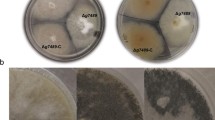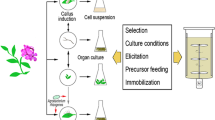Abstract
Epothilones are a kind of 16-member macrolides with strong anticancer activity, which was produced by Sorangium cellulosum. Epothlione D shows better drug resistance and safety than taxol in clinical trials. However, the low yield of epothilone D in Sorangium cellulosum and thereof toxicity limited the application of epothilone D. In this study, the epoK gene in gene cluster for epothilone was firstly inactivated by the employment of TALEN gene knockout system. The qRT-PCR analysis and sequencing were performed to confirm the gene deletion of epoK, resulting in the epothilone D yield improvement by 34.9±1.6% and the decrease of epothilone B yield by 34.2±2.5%, which was demonstrated by LC–MS analysis. This study would lay a foundation for the yield improvement of epothilones D, B and thereof derivatives in S. cellulosum by genetic engineering, thus promoting the applications of epothilones in the field of anticancer.





Similar content being viewed by others
Data Availability
The authors declare that all data supporting the findings of this study are available within the article.
References
Höfle, G., Bedorf, N., Steinmetz, H., Schomburg, D., Gerth, K., & Reichenbach, H. (1996). Epothilone A and B-novel 16-membered macrolides with cytotoxic activity: Isolation, crystal structure, and conformation in solution. Angewandte Chemie, 35, 1567–1569.
Bollag, D. M., McQueney, P. A., Zhu, J., Hensens, O., Koupal, L., Liesch, J., Goeta, M., Lazarides, E., & Woods, C. M. (1995). Epothilones, a new class of microtubule-stabilizing agents with a taxol-like mechanism of action. Cancer Research, 55, 2325–2333.
Goodin, S., Kane, M. P., & Rubin, E. H. (2004). Epothilones: Mechanism of action and biologic activity. Journal of Clinical Oncology, 22, 2015–2025.
Sepp-Lorenzino, L., Balog, A., Su, D.-S., Meng, D., Timaul, D., Danishefsky, S. J., & Rosen, N. (1999). The microtubule-stabilizing agents epothilones A and B and their desoxy-derivatives induce mitotic arrest and apoptosis in human prostate cancer cells. Prostate Cancer and Prostatic Diseases, 2, 41–52.
Oehler, C., Frei, K., Rushing, E. J., McSheehy, P. M., Weber, D., Allegrini, P. R., Weniger, D., Lutolf, U. M., Knuth, A., & Yonekawa, Y. (2012). Patupilone (epothilone B) for recurrent glioblastoma: Clinical outcome and translational analysis of a single-institution phase I/II trial. Oncology, 83, 1–9.
Nicolaou, K. C., Vourloumis, D., Li, T., Pastor, J., & Finlay, M. R. V. (2010). Designed epothilones: Combinatorial synthesis, tubulin assembly properties, and cytotoxic action against taxol-resistant tumor cells. Angewandte Chemie, 36(19), 2097–2103.
Gupta, D., & Mani, S. (2009). The efficacy and safety of ixabepilone monotherapy in the treatment of breast and gynecologic malignancies. Drug Safety Evaluations, 8, 81–88.
Wang, L. J., & Hai-Feng, H. U. (2011). Research progress of epothilone B, D and their derivatives. World of Clinical Drugs, 7, 416–419.
Wessjohann LA, Scheid G, Bornscheuer U, Henke E, Kuit W, Orru R (2006). Epothilone synthesis components i: asymmetrically substituted acyloins and acyloin derivatives, method for the production thereof and method for the production of epithilone and epothilone derivatives. EP. EP1358144.
Brunden, K. R., Zhang, B., Carroll, J., Yao, Y., Potuzak, J. S., Hogan, A., Iba, M., James, M. J., Xie, S. X., & Ballatore, C. (2010). Epothilone D improves microtubule density, axonal integrity, and cognition in a transgenic mouse model of tauopathy. Journal of Neuroscience, 30(41), 13861–13866.
Xue, W., Zhang, H., Fan, Y., & Xiao, Z. (2021). Dai J (2021) Upregulation of apol8 by epothilone D facilitates the neuronal relay of transplanted NSCs in spinal cord injury. Stem Cell Research & Therapy, 12, 300.
Julien, B., Shah, S., Ziermann, R., Goldman, R., Katz, L., & Khosla, C. (2000). Isolation and characterization of the epothilone biosynthetic gene cluster from Sorangium cellulosum. Gene, 249, 153–160.
Tang, L., Shah, S., Chung, L., Carney, J., Katz, L., Khosla, C., & Julien, B. (2000). Cloning and heterologous expression of the epothilone gene cluster. Science, 287, 640–642.
Julien, B., & Shah, S. (2002). Heterologous expression of epothilone biosynthetic genes in Myxococcus xanthus. Antimicrob Agents Chem, 46, 2772–2778.
Mutka, S. C., Carney, J. R., Liu, Y., & Kennedy, J. (2006). Heterologous production of epothilone C and D in Escherichia coli. Biochemistry, 45, 1321–1330.
Gerth, K., Pradella, S., Perlova, O., Beyer, S., & Muller, R. (2003). Myxobacteria proficient producers of novel natural products with various biological activities-past and future biotechnological aspects with the focus on the genus Sorangium. Journal of Biotechnology, 106(3), 233–253.
Jaoua, S., Neff, S., & Schupp, T. (1992). Transfer of mobilizable plasmids to Sorangium cellosum and evidence for their integration into the chromosome. Plasmid, 28, 157–165.
Xia, Z., Wang, J., Hu, W., Liu, H., Gao, X., Wu, Z., Zhang, P., & Li, Y. (2008). Improving conjugation efficacy of Sorangium cellulosum by the addition of dual selection antibiotics. Journal of Microbiology and Biotechnology, 35, 1157–1163.
Han, S. J., Park, S. W., Park, B., & Sim, S. J. (2008). Selective production of epothilone B by heterologous expression of propionyl-CoA synthetase in Sorangium cellulosum. Journal of Microbiology and Biotechnology, 18, 135–137.
Ye, W., Zhang, W. M., Chen, Y. C., Li, H. H., Li, S. N., & Pan, Q. L. (2016). A new approach for improving epothilone B yield in Sorangium cellulosum by the introduction of vgb epoF genes. Journal of Microbiology and Biotechnology, 43(5), 1–10.
Ye, W., Liu, T. M., Zhu, M. Z., Zhang, W. M., Huang, Z. L., & Li, S. N. (2019). An easy and efficient strategy for the enhancement of epothilone production mediated by TALE-TF and CRISPR/dCas9 systems in Sorangium cellulosum. Frontiers in Bioengineering Biotechnology, 7, 334.
Sanjana, N. E., Cong, L., Zhou, Y., Cunniff, M. M., Feng, G., & Zhang, F. (2012). A TAL effector toolbox for genome engineering. Nature Protocols, 7, 171–192.
Deng, D., Yan, C., Pan, X., Mahfouz, M., Wang, J., Zhu, J., Shi, Y., & Yan, N. (2012). Structural basis for sequence-specific recognition of DNA by TAL effectors. Science, 335, 720–723.
Uhde-Stone, C., Huang, J., & Lu, B. (2012). A robust dual reporter system to visualize and quantify gene expression mediated by transcription activator-like effectors. Biological Procedures Online, 14, 1–8.
Uhde-stone, C., Cheung, E., & Lu, B. (2014). TALE activators regulate gene expression in a position—and strand-dependent manner in mammalian cells. Biochemical and Biophysical Research Communications, 443, 1189–1194.
Joung, J. K., & Sander, J. D. (2013). TALENs: A widely applicable technology for targeted genome editing. Nature Reviews Molecular Cell Biology, 14, 49–55.
Ye, W., Zhang, W. M., Liu, T. M., Tan, G. H., Li, H. H., & Huang, Z. L. (2016). Improvement of ethanol production in Saccharomyces cerevisiae by high-efficient disruption of the adh2 gene using a novel recombinant talen vector. Frontiers in Microbiology, 7, 1067.
Molnar, I., Schupp, T., Ono, M., Zirkle, R., Milnamow, M., Nowak-Thompson, B., Engel, N., Toupet, C., Stratmann, A., & Cyr, D. D. (2000). The biosynthetic gene cluster for the microtubule-stabilizing agents epothilones A and B from Sorangium cellulosum So ce90. Chem Bio, 7, 97–109.
Pradella, S., Hans, A., Spröer, C., Reichenbach, H., Gerth, K., & Beyer, S. (2002). Characterisation, genome size and genetic manipulation of the myxobacterium Sorangium cellulosum So ce56. Archives Microbiol, 178, 484–492.
Liang, J. H., Wang, H. M., Bian, X. Y., Zhang, Y. M., Zhao, G. P., & Ding, X. M. (2020). Heterologous redox partners supporting the efficient catalysis of epothilone B biosynthesis by EpoK in Schlegelella brevitalea. Microbial Cell Factories, 19, 1–13.
Zhu, L., Li, Z., Sun, X., Li, S., & Li, Y. (2013). Characteristics and activity analysis of epothilone operon promoters from Sorangium cellulosum strains in Escherichia coli. Applied Microbiology and Biotechnology, 97, 1–10.
Bian, X. Y., Tang, B., Yu, Y. C., Tu, Q., Gross, F., Wang, H. L., Li, A. Y., Fu, J., Shen, Y. M., Li, Y. Z., Stewart, A. F., Zhao, G. P., Ding, X. M., Muller, R., & Zhang, Y. M. (2017). Heterologous production and yields improvement of epothilones in the Burkholderiales strain DSM 7029. ACS Chemical Biology, 12(7), 1805–1812.
Yu, Y., Wang, H., Tang, B., Liang, J., & Ding, X. (2020). Reassembly of the biosynthetic gene cluster enables high epothilone yield in engineered Schlegelella brevitalea. ACS Synthetic Biology, 9, 2009–2022.
Qiu L (2010) Isolation of Sorangium cellulosum and bioactivity of secondary metabolites. Dissertations & Theses-Gradworks.
Acknowledgements
We also thank Ye Zhenggui for his help.
Funding
This research was funded by the National Natural Science Foundation of China (Grant Nos. 31500037, 31800063, 41906106), the Natural Science Foundation of Guangdong province (2019A1515011829, 2019A1515011702), the GDAS Project of Science and Technology Development (2020GDASYL-20200105001), and the Guangdong Special Support Program (2019TQ05Y375).
Author information
Authors and Affiliations
Contributions
WY and WMZ conceived and designed the research and revised the manuscript. WY and TML conducted the experiments. SNL and HHL contributed strains. WY, TML, and WYZ analyzed the data. WY wrote the manuscript. . All authors read and approved the manuscript.
Corresponding author
Ethics declarations
Conflict of interest
All the authors declared no conflict of interest.
Ethical Approval
No ethical experiment was involved in this study.
Additional information
Publisher's Note
Springer Nature remains neutral with regard to jurisdictional claims in published maps and institutional affiliations.
Rights and permissions
Springer Nature or its licensor (e.g. a society or other partner) holds exclusive rights to this article under a publishing agreement with the author(s) or other rightsholder(s); author self-archiving of the accepted manuscript version of this article is solely governed by the terms of such publishing agreement and applicable law.
About this article
Cite this article
Ye, W., Liu, T., Zhang, WM. et al. The Improvement of Epothilone D Yield by the Disruption of epoK Gene in Sorangium cellulosum Using TALEN System. Mol Biotechnol 65, 282–289 (2023). https://doi.org/10.1007/s12033-022-00602-0
Received:
Accepted:
Published:
Issue Date:
DOI: https://doi.org/10.1007/s12033-022-00602-0




